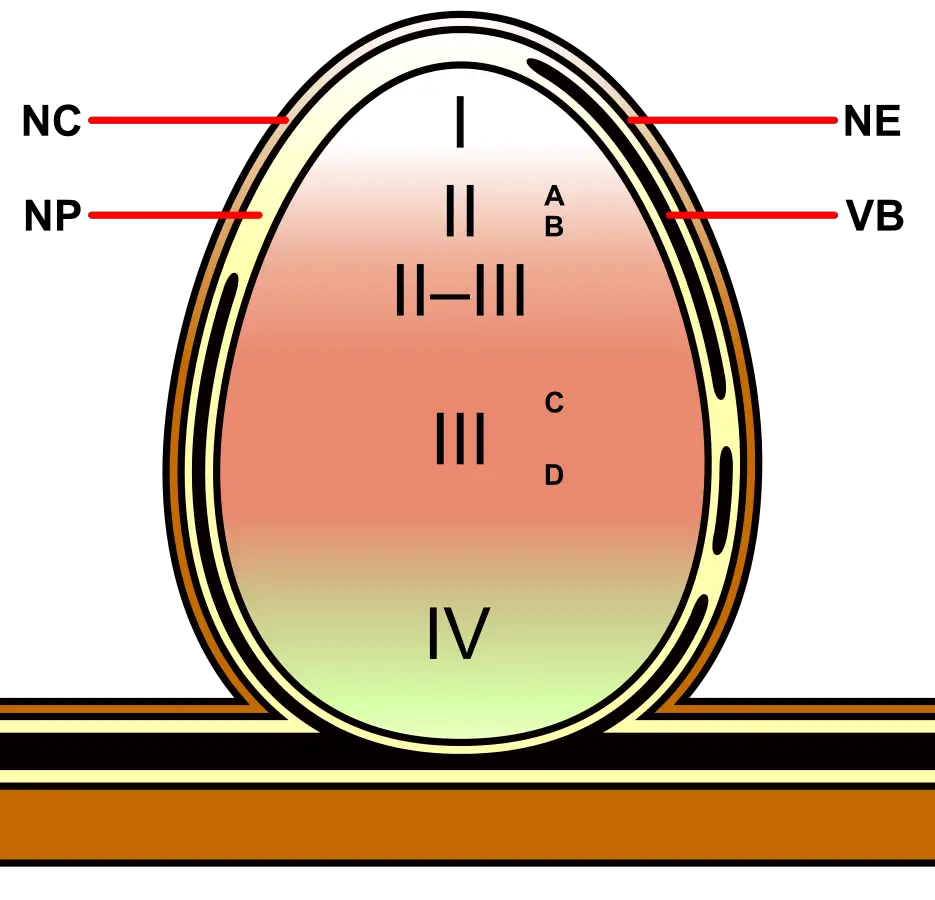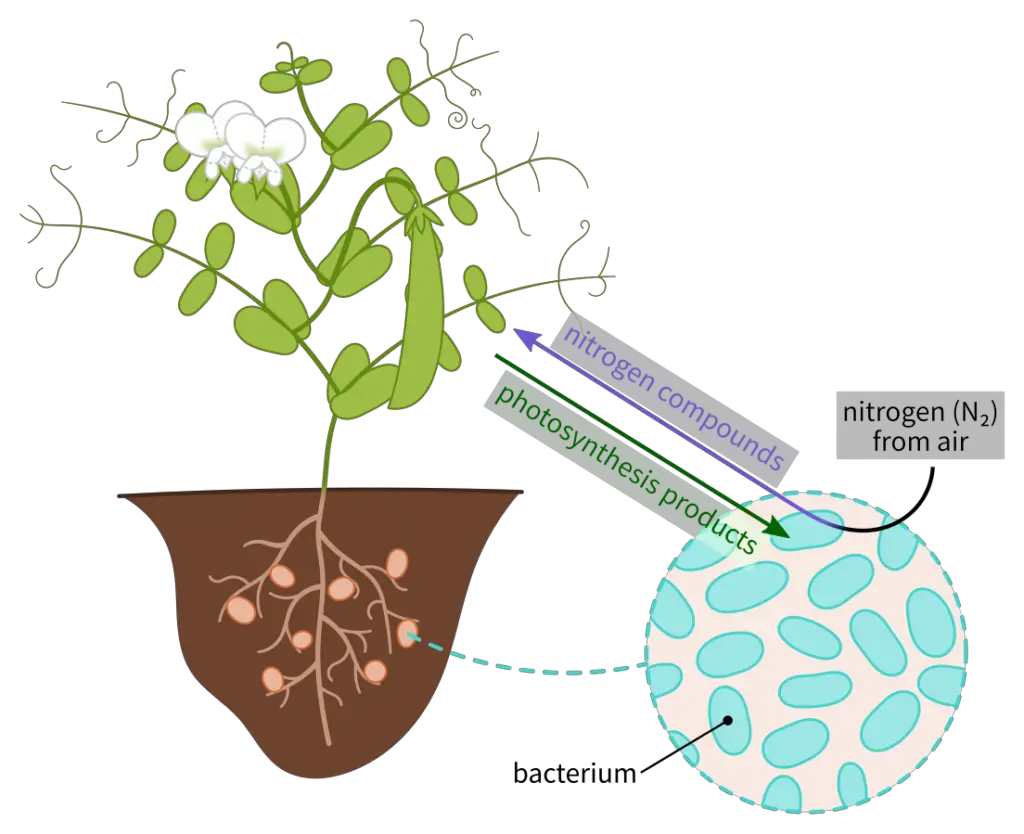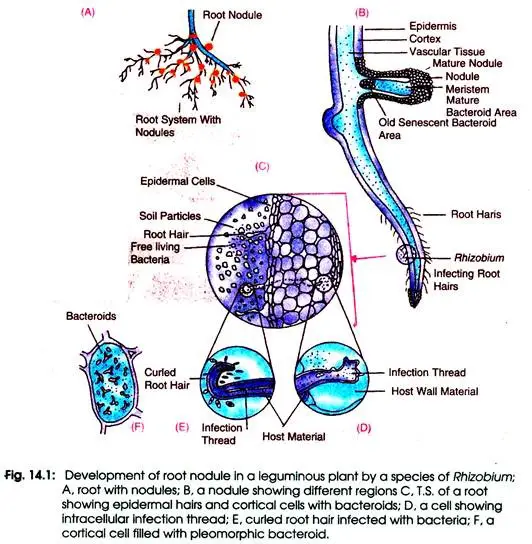Table of Contents
What is Nodule?
- Commonly found in the roots of leguminous plants are nodules.
- The production of nodules is known as nodulation.
- They are the result of a relationship with the nitrogen-fixing bacteria Rhizobium.
- Rhizobia is the umbrella word for various nitrogen-fixing bacterial taxa, such as Rhizobium, Bradyrhizobium, etc.
- Plants cannot directly absorb nitrogen from the atmosphere. These bacteria convert ambient nitrogen to ammonia, which plants can use to synthesise macromolecules such as amino acids, nucleotides, etc.
- It is an excellent method for enhancing the nitrogen content of the soil.
- As a biofertilizer, it minimises the need for chemical fertilisers.
- Once the legume plant dies, nitrogen is released into the soil, making it accessible to other plants.
- Root nodules are typically observed in leguminous plants and members of the Fabaceae family. Examples include peas, beans, soy, alfalfa, and clover.
- Some non-leguminous plants produce root nodules, including Parasponia, which is noduled by Rhizobia, and alder and bayberry, which are noduled by Frankia.
- Some taxa within the family Rosaceae also contain root nodules.
Root Nodule Types
In legumes, two major forms of nodules have been identified: determinate and indeterminate.
Determinate nodules
- Determinate nodules are found on some tropical legume tribes, such as those of the genera Glycine (soybean), Phaseolus (common bean), and Vigna, as well as on some temperate legumes, such as Lotus.
- These determinate nodules cease meristematic activity shortly after start; hence, their growth is due to cell expansion, resulting in spherical, mature nodules.
- A vast variety of herbs, shrubs, and trees, such as Arachis, include another type of determinate nodule (peanut).
- These are always connected with the axils of lateral or adventitious roots and are created as a result of infection through fissures where these roots emerge, as opposed to the use of root hairs.
- Their interior structure differs significantly from that of soybean nodules.
Indeterminate nodules
- In both temperate and tropical environments, the majority of legumes from all three subfamilies include indeterminate nodules.
- They are present in Faboideae legumes such as Pisum (pea), Medicago (alfalfa), Trifolium (clover), and Vicia (vetch), as well as in all mimosoid legumes such as acacias and the rare noduled caesalpinioid legumes such as partridge pea.
- They got the name “indeterminate” because their apical meristem creates new cells for growth throughout the nodule’s lifetime.
- This causes the nodule to have an usually cylindrical shape that may be highly branching.
- Due to their dynamic growth, indeterminate nodules exhibit zones that demarcate several stages of development/symbiosis:
- Zone I—Zone I represents the active meristem. Here, fresh nodule tissue is generated, which will later differentiate into the nodule’s other zones.
- Zone II—Zone II is the infected area. This region is saturated with bacterial-laden infection threads. The plant cells are larger than they were in the preceding zone, and cell division ceases.
- Interzone II–III — Here, the bacteria have invaded the amyloplast-containing plant cells. They elongate and initiate terminal differentiation into nitrogen-fixing symbiotic bacteroids.
- Zone III—Zone III is the zone of nitrogen fixation. Each cell in this zone has a huge central vacuole, and the cytoplasm is packed with fully developed, nitrogen-fixing bacteroids. These cells get leghemoglobin from the plant, resulting in a characteristic pink hue.
- Zone IV—the senescent zone. In this location, plant cells and their bacteroid contents are degrading. The degradation of the heme component of leghemoglobin causes a greening of the nodule’s base.

Symbiosis
Leguminous family
- Included in the Fabaceae family of nitrogen-fixing plants are taxa such as kudzu, clovers, soybeans, alfalfa, lupines, peanuts, and rooibos.
- In the nodules, symbiotic bacteria known as rhizobia produce nitrogen compounds that help the plant grow and compete with other plants.
- When a plant dies, the fixed nitrogen is freed, making it accessible to other plants and helping to fertilise the soil.
- Only a few genera (e.g., Styphnolobium) do not have this association: the vast majority of legumes.
- In order to take advantage of this, fields are typically rotated among various types of crops, including one consisting primarily or totally of a leguminous crop such as clover, in many traditional farming systems.
Non-leguminous
- Although the vast majority of nitrogen-fixing root nodule-forming plants belong to the legume family Fabaceae, there are a few exceptions:
- Thanks to a symbiotic relationship with Frankia bacteria, actinorhizal plants like alder and bayberry are able to develop (less complex) nitrogen-fixing nodules. These plants belong to a total of 25 genera and eight plant families. According to a 1998 count, it consists of approximately 200 species and is responsible for almost the same amount of nitrogen fixation as rhizobial symbioses. An key structural distinction is that the bacteria are never liberated from the infection thread in these symbioses.
- The tropical Cannabaceae genus Parasponia can also interact with rhizobia and generate nitrogen-fixing nodules. As similar plants are actinorhizal, it is hypothesised that the plant throughout its evolution “swapped partners.”
- The capacity to fix nitrogen is by no means universal in these families. Only four genera out of 122 in the Rosaceae family are capable of fixing nitrogen.
- All of these families belong to the orders Cucurbitales, Fagales, and Rosales, which form a nitrogen-fixing clade (NFC) of eurosids with the Fabales.
- In this clade, Fabales were the first to diverge; therefore, the ability to fix nitrogen may be plesiomorphic and lost in most descendants of the original nitrogen-fixing plant; however, the basic genetic and physiological requirements may have been present in an embryonic state in the last common ancestor of all these plants.

Root Nodule Formation Steps – Nodulation Briefly Describe
When the soil contains a low concentration of nitrogen, root nodule development begins. The two symbiotic partners rely on cell signalling for association and nodule development. These are the stages of nodulation:
- The flavonoids secreted by legume roots attract rhizobia to the root. Rhizobia cluster near root hairs.
- Rhizobia secrete nod factors, also known as nodulation factors, which cause root hairs to curl around them.
- Nod factors promote numerous developmental alterations, including membrane depolarization, root hair curling, cell division in the root cortex, and intracellular calcium transport.
- Nod factor binds to receptors on the plasma membrane of root hairs, resulting in the creation of an infection thread. Rhizobia can also infiltrate root cells through fractures.
- Infection thread provides bacteria with access to epidermal cells.
- Rhizobia subsequently penetrate cortical cells, where each bacteria is enveloped by a membrane formed by the plant and known as a symbiosome.
- Rhizobia generate substances that stimulate the production of nodules. It is caused by a calcium-dependent signal transduction system that initiates metabolic changes that culminate in cell division and nodule formation.
- Cytokinin also plays a significant role in the formation of nodules.
- Within nodules, bacteria develop into nitrogen-fixing bacteroids. Nodules are created with vascular tissues to facilitate the flow of nutrients.
Process of Root Nodule Formation
Rhizobia are soil-dwelling organisms that, upon contact with a suitable host, initiate the process of infection. Initial interaction between a bacterium and its host is dependent on recognition.
Recent research suggests that polysaccharides on the surface of invasive bacteria link these cells to components (lectins) on the surface of the roots. Nodulins are the factors or proteins found in nodules, whereas bacteriocins are found on bacterial surfaces and aid in nodulation. Nodulation generally begins with the following processes:
1. Curling and Deformation of Root Hairs
Rhizobia invade plants by root hairs. Fine investigations of infected root hairs revealed the continuity of the infection thread’s wall with the root hair’s cell wall, lending support to the invagination idea.
Below is a summary of the physiological processes that lead to infection.

2. Formation of Infection – thread and Formation of Nodule
- It is fascinating that such connections develop between compatible partners (bacteria and host).
- The tip of the coiled root hair curves, and the bacteria (rhizobial polysaccharide and DNA) enter and proliferate as an infection tube.
- In the meantime, the polysaccharides react with a root hair cell component to generate a “organiser.”
- The ‘organiser’ stimulates the formation of polygalacturonase (PG), which is followed by the depolymerization of cell wall pectin.
- This process involves the inclusion of rhizobia into the cell wall, which contributes to ‘intussusception,’ or the absorption of rhizobia by root hair and its transformation into organic tissues.
- The infection tube or thread branches towards the nodule’s centre, and the bacteria discharged into the cytoplasm of the symbiont multiply. Rhizobia are guided by the nucleus of root hair cells.
3. Development of Nodule
- Immediately following the release of rhizobia into the cytoplasm of the host cortical cells, hyperplasia (rapid cell division) occurs in the cortical cells.
- Inside of these cells, bacteria transform into bigger forms known as bacteroids.
- This infection stimulates the formation of a tumor-like nodule of bacteroid-packed root cells.
- The chromosome count of the area’s host cells doubles. The duplication of chromosomes occurs in the nodules of both polyploid and diploid legumes.
Structure of root nodule
- The formation of root nodules is triggered by the activity of rhizobial growth promoters, most likely by cytokinesis.
- The “bacteroid zone” comprises the centre of a mature nodule and is surrounded by multiple layers of cortical cells.
- The cytoplasm of a plant cell is inhabited by bacteroids, either singly or in groups, enclosed by peribacteroid membranes.
- Due to the presence of leghaemoglobin and well-developed and organised tissue, effective nodules are typically big and pink.
- When the nodule reaches senescence and dies, the stationary-phase rhizobia are discharged into the soil.
Function of the nodule ‘bacteroids’
- According to the available information, bacteroids are the sites of nitrogen fixation.
- According to the isotopic (15N) investigations, bacteroids are the major sites of nitrogen fixation.
- Moreover, unlike free-living rhizobia, bacteroids cannot utilise sugar and produce ammonium ions, which are reportedly converted into organic compounds by glutamine synthetase in the surrounding plant cell.
- This process demonstrates the presence of genuine mutual symbiosis, in which the role of leghaemoglobin in the fixation of nitrogen is significantly more important.
- Leghaemoglobin production is a unique result of the symbiosis. Effectiveness refers to the relative capacity of the plant – bacterial interaction, once established, to digest molecular nitrogen.
Leghaemoglobin
- There is a red pigment comparable to blood haemoglobin in the nodules between bacteroids and their surrounding membrane envelopes.
- Leghaemoglobin, the prefix ‘leg’ denoting its occurrence in legume root nodules, is a haemoprotein consisting of a haeme moiety synthesised by bacteria and connected to a peptide chain representing the globin portion of the molecule, which is encoded by a plant gene.
- The molecular weight of leghaemoglobin is approximately 16,000-17,000 Daltons, whereas the molecular weight of blood haemoglobin is approximately 66,000 Daltons.
- The prosthetic group protohaem is generated by bacteroids, whereas the protein portion is synthesised by plant cells.
- The induction of leghaemoglobin increases the transfer of oxygen at low partial pressure to the nodules and regulates a consistent supply of oxygen at low concentration in the nodules.
- It is not analysed in cyanobacterial symbiotic systems or in higher plants that fix nitrogen without leghaemoglobin, such as Frankia and Parasponia.
- The presence of leghaemoglobin appears to provide the N2 fixing enzyme with complete protection against oxygen damage.
Free-living nitrogen fixing bacteria
- There are 54 genera comprised of 22 families and 3 thermophilic archaeobacteria that fix nitrogen in their free-living state. Winogradsky proved biological nitrogen fixation in Clostridium pasteurianum in 1893, while Beijerinck discovered it in Azotobacter in 1901.
- It has been demonstrated that approximately 30 genera of cyanobacteria representing 10 families can fix atmospheric nitrogen. Cyanobacteria are heterocystous, filamentous, nonheterocystous filamentous, unicellular, and they reproduce via binary fission, budding, and multiple fission.
- Other N2 fixing organisms:
- Lichens (Cyanobacteria – fungus association)
- Liverworts (Anabaena – Anthoceros)
- Pteridophytes (Anabaena azollae – Azolla)
- Gymnosperms (Nostoc – Cycads)
- Angiosperms (Nostoc – Gunnera)
- Termites (with Citrobacters)
- Human intestine (Klebsiellae)
Factors Affecting Nodule Formation
Both environmental and internal variables influence nodulation.
- External influences include temperature, soil acidity and nitrate concentration, etc.
- If the soil is high in nitrogen, it inhibits nodule formation and symbiotic connection since plants already have sufficient nitrogen and do not require more.
- The nitrogen fixation process is oxygen-sensitive. The root nodules contain leghaemoglobin, a heme pigment that aids the transport of oxygen.
- Leaf tissues autoregulate nodule development. Plants have evolved anti-infection defensive systems.
- Internally, ethylene also governs nodule formation. Application of ethylene exogenously has been found to reduce nodule formation.
Key facts
- The nodule is a specialised organ or outgrowth on the roots of the host plant, particularly those of the Fabaceae (Leguminosae) family, which carries Rhizobium bacteria.
- Nitrogen fixation is the process by which Rhizobia bacteria convert nitrogen gas (N2) to ammonia (NH3).
- The majority of plants with root nodules are legumes, such as beans, peas, peanuts, alfalfa, lupines, and soybeans.
- Nodules contain symbiotic bacteria known as Rhizobia that perform nitrogen fixation and boost soil fertility by increasing the nitrate concentration.
- Most of them, including pea, alfalfa, clover, vetch, etc., have intermediate nodules with an active meristem that is responsible for the creation of new cells as the nodule grows.
- Determinate nodules are seen on tropical legumes such as soy, common bean, etc., as well as certain temperate legumes such as Lotus. Here, the nodules have a spherical shape.
References
- Eckardt NA. The Role of Flavonoids in Root Nodule Development and Auxin Transport in Medicago truncatula. Plant Cell. 2006 Jul;18(7):1539–40. doi: 10.1105/tpc.106.044768. PMCID: PMC1488913.
- Pii, Y., Crimi, M., Cremonese, G. et al. Auxin and nitric oxide control indeterminate nodule formation. BMC Plant Biol 7, 21 (2007). https://doi.org/10.1186/1471-2229-7-21
- Salt, G. (1970). NODULE FORMATION. In The Cellular Defence Reactions of Insects (Cambridge Monographs in Experimental Biology, pp. 51-55). Cambridge: Cambridge University Press. doi:10.1017/CBO9780511721960.004
- Franssen, H.J. et al. (1992). Nodule formation and hormone balance. In: Karssen, C.M., van Loon, L.C., Vreugdenhil, D. (eds) Progress in Plant Growth Regulation. Current Plant Science and Biotechnology in Agriculture, vol 13. Springer, Dordrecht. https://doi.org/10.1007/978-94-011-2458-4_62
- Bhat, Tauseef & Ahmad, Drlatief & Ganai, Manzoor & Khan, Owais. (2015). Nitrogen Fixing Biofertilizers; Mechanism and Growth Promotion: A Review. Journal of Pure and Applied Microbiology. 9. 1675-1690.
- Stacey, G. (2007). The Rhizobium-Legume Nitrogen-Fixing Symbiosis. Biology of the Nitrogen Cycle, 147–163. doi:10.1016/b978-044452857-5.50011-4
- Göttfert M. Regulation and function of rhizobial nodulation genes. FEMS Microbiol Rev. 1993 Jan;10(1-2):39-63. doi: 10.1111/j.1574-6968.1993.tb05863.x. PMID: 8431309.
- https://biology.anu.edu.au/news-events/news/nodulation-legumes
- https://collegedunia.com/exams/nodule-formation-formation-and-factors-affecting-nodule-formation-biology-articleid-1592
- https://www.sciencedirect.com/topics/biochemistry-genetics-and-molecular-biology/root-nodule
- https://gcwgandhinagar.com/econtent/document/1587178867UNIT%204.1%20Formation%20of%20Root%20Nodules%20in%20Legumes.pdf
- https://forages.oregonstate.edu/nfgc/eo/onlineforagecurriculum/instructormaterials/availabletopics/nitrogenfixation/infection
- https://www.vedantu.com/neet/nodule-formation
- https://en.wikipedia.org/wiki/Root_nodule



El artículo es muy didactico. Desearía saber cual es el tiempo en que demora el nódulo en fijar nitrógeno desde que las raices son infectadas en el trébol blanco. Gracias